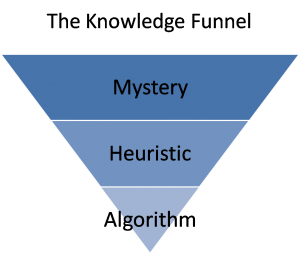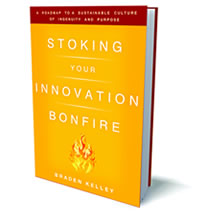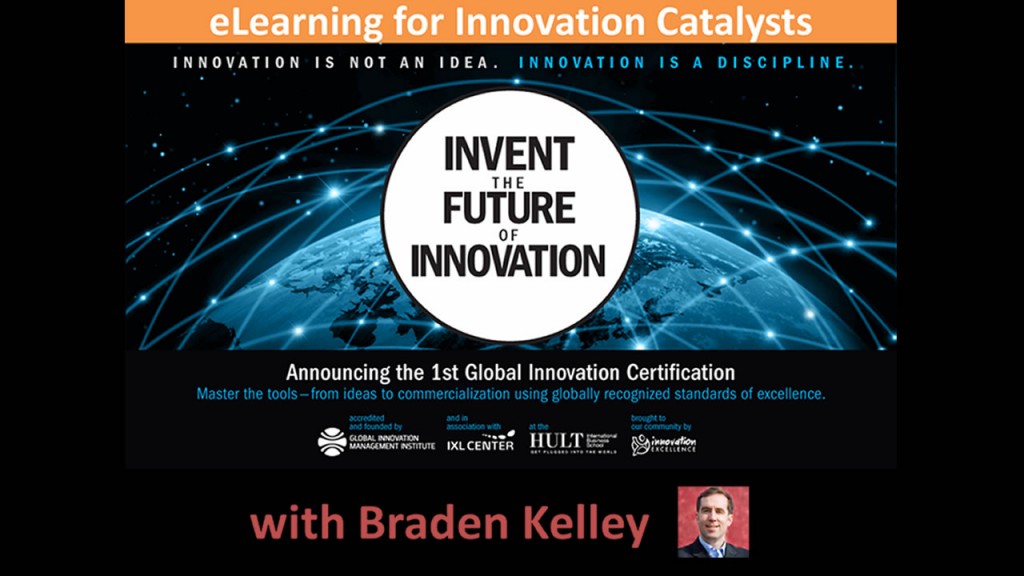Don’t Be a Know It All

by Braden Kelley
Trying to be a “know-it-all” is a flawed goal.
It is impossible to know everything.
This is by design.
This is by intention.
In much the same way that programming languages have garbage collection built in, the human brain is built to prune. The human brain is built to forget more than it remembers. Instead of trying to override our natural tendencies, we must embrace them and see instead see how they empower us to be continuous learners.
“Garbage collection is the process in which programs try to free up memory space that is no longer used by objects.” — FreeCodeCamp

And while knowledge is important, it is perishable, it is transitory, and it is not the highest aspiration.
- An understanding of data allows the creation of information
- The consumption of information allows the creation of knowledge
- The exploration of knowledge allows the creation of insight
- The connections between insights allow the creation of wisdom
Curiosity fuels the transformation of data and information into insights and wisdom, while knowledge funnel progression is driven by a quest for efficiency.
Knowledge Funnel
 The knowledge funnel is a useful concept learned from Roger Martin in the Design of Business. The concept highlights how any new area creating information (and hopefully knowledge) starts very much as a mystery, but as our understanding of the topic area increases, we begin to identify heuristics and make sense of it. For me, this is where we begin to move from data and information to knowledge, and then as our knowledge increases we are able to codify this knowledge into algorithms.
The knowledge funnel is a useful concept learned from Roger Martin in the Design of Business. The concept highlights how any new area creating information (and hopefully knowledge) starts very much as a mystery, but as our understanding of the topic area increases, we begin to identify heuristics and make sense of it. For me, this is where we begin to move from data and information to knowledge, and then as our knowledge increases we are able to codify this knowledge into algorithms.
Importance of Curiosity to a Learn It All Culture
If you want to build a learn-it-all culture, it all starts with curiosity. Curiosity leads to inquiry, and inquiry leads to learning. The achievement of insights is the ideal outcome for learning pursuits, and insights power innovation.
I’ve been writing about the importance of curiosity and its role in innovation since 2011 or before.
“The important thing is not to stop questioning. Curiosity has its own reason for existing.” – Albert Einstein
At an event I attended in New York City in 2011, Peter Diamandis of the XPRIZE Foundation talked about how for him the link between curiosity and innovation is the following:
“What should be possible that doesn’t yet exist?”
In my article Key to Innovation Success Revealed!, on the topic of curiosity I wrote:
The reason that curiosity is the secret to innovation success is that the absence of curiosity leads to acceptance and comfort in the status quo. The absence of curiosity leads to complacency (one of the enemies of innovation) and when organizations (or societies) become complacent or comfortable, they usually get run over from behind. When organizations or societies lack curiosity, they struggle to innovate. Curiosity causes people to ask ‘Why’ questions and ‘What if’ questions. Curiosity leads to inspiration. Inspiration leads to insight. Insights lead to ideas. And in a company or society where invention, collaboration and entrepreneurship knowledge, skills, abilities and practice are encouraged, ideas lead to action.
Five Keys to Building a Learn It All Culture
Change is the one constant, and it is continuous. If it wasn’t, all of us would still be hunting animals and collecting berries. Embracing continuous change and transformation allows us to accelerate our understanding of the universe and how our organizations can serve their missions more effectively and efficiently. Continuous change requires continuous learning. To prepare our people and our organization to succeed at continuous learning we need to do these five things:
1. Develop Good Learning Hygiene
Learning is a skill. To build an organization of continuous or lifelong learners, we must first help people learn how to learn. Two of the most important learning skills that we are not taught how to do in school, but that are crucial for success at innovation and other modern pursuits are the following:
- Deep Thinking — Few of us are good at deep thinking and as a result, deep learning. Getting people to put all of their devices away is the initial challenge. Feeling comfortable not knowing the answer and sitting at a table with nothing more than a blank piece of paper is really hard. Teaching people how to meditate beforehand can be quite helpful. The goal of course is to get people into the state of mind that allows them to think deeply and capture their idea fragments, nuggets of inquiry and micro-inspirations. This will provide the fuel for collaboration and co-creation and the next key learning skill.
- Augmented Learning — We live during amazing times, where if we don’t know something we can Google it or ask Siri, Cortana or Alexa. All of the assistants and search engines available to us, serve to quickly augment our human knowledge, skills and abilities. Knowing how to build good search queries is an incredibly powerful life skill. Teach it.
2. Reinforce Growth Mindset Behaviors
There has been much chatter about the difference between a fixed mindset and a growth mindset. It’s not really a new concept, but instead modern packaging for the level of maturity shown by those successful professionals who are willing to say:
“I don’t know.” and “Let me find out.” and “Failure is an opportunity to learn.”
Two ways organizations can demonstrate their commitment to a growth mindset are to:
- Celebrate Failure — Create events or other ways to share some of the most important failures of the month or quarter, and what was learned from each.
- Fund Curiosity — If you’re hiring curious people with a growth mindset, then every employee will be curious about something. Find a way to fund their investigation and exploration of what they’re curious about – even if it is not work-related. This is a great way of demonstrating the importance of curiosity to innovation and your commitment to it.
3. Make Unlearning Socially Acceptable
We all want to be the expert, and we work hard to achieve mastery. Meaning, often we hold on too tightly as new solutions emerge. And, to adopt new ways of solving old problems, often we have to unlearn what we think we know before we can learn the new ways. Smart organizations constantly challenge what they think they know about their customers, potential partners, product-market-fit, and even where future competition might come from.
4. Flex Your Reskilling and Retraining Muscles
With the accelerating pace of change, the organizations and even the countries that invest in reskilling and retaining their employees (or citizens) are the organizations and economies that stand the best chance of continued success. As more organizations commit to being purpose-driven organizations, the costs of recruitment actually increase, making it even more important to keep the employees you attract and to reskill and retrain them as your needs change. Especially as the pace of automation also increases…
5. Create Portable Not Proprietary Knowledge
If you gave an employee ten hours to spend to either:
- Earn a professional certification
- Complete company-created employee training
Which do you think most employees would choose?
Sorry, but most employees view company-created trainings somewhat like the dentist. They do it because they have to.
Work with professional associations to influence certification curriculums towards the knowledge, skills and abilities you need.
Find more and better ways of encouraging mentorship.
Invest in internal internship and innovation programs that allow employees to explore the ideas and the other areas of the business they’re passionate about.
Conclusion
Transitioning from a know-it-all to a learn-it-all culture is no small feat and requires commitment and investment at a number of different levels inside the organization. I’ve highlighted the five keys to building a learn-it-all culture inside your organization, but only you can take the keys and unlock these capabilities inside your organization. Now is the time to invest in your learning transformation.
But smart countries will be thinking bigger. Smart countries will be thinking about how they can transform their educational systems to create a continuous learning mindset in their next generation, finance a move from STEM to STEAM, and commit to ongoing worker reskilling and retraining programs to support displaced workers.
![]() Sign up here to get Human-Centered Change & Innovation Weekly delivered to your inbox every week.
Sign up here to get Human-Centered Change & Innovation Weekly delivered to your inbox every week.




 As the end of 2013 approaches, why not give your employees and your organization the gift of innovation for 2014?
As the end of 2013 approaches, why not give your employees and your organization the gift of innovation for 2014?



